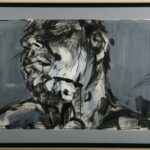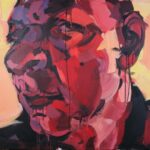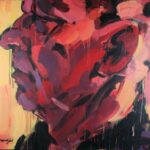
Viningas Virginijus
Painter, stained glass artist.
Born in 1960 in Pasvalys.
From 1984 to 1990, he studied painting at the State Institute of Art of the LSSR.
Since 1988, he has been participating in exhibitions.
Lives in Klaipėda, works as a teacher at the E. Balsys Art Gymnasium.
His works are in the Lithuanian Art Museum, private collections in Lithuania and abroad.
Virginijus Viningas is an artist whose physical location and pedagogical activity have been associated with Klaipėda for many years. Having moved to the port city in the last decade of the 20th century, the artist, who was born in Pasvalys and graduated from the Vilnius Academy of Arts (then the State Institute of Art of the LSSR), taught painting at the Faculty of Arts of Klaipėda University, and currently teaches at the Eduards Balsys Art Gymnasium. Vinings actively participates in the activities of the Klaipėda County Artists’ Union, of which he has been a member since 1997.
However, his own work, at least thematically, is not at all related to the sea, waves or pine trees. The author is inspired neither by the sand of the seashore, nor by the sun setting on the waves, nor by sails stretched by the wind, nor by storm clouds over the sea, by the pier or by seagulls. Nor by the truly rich and interesting history of Klaipėda. The human body is most interesting to Vinings. However, in his canvases we will not find academic nudes, body studies; the artist is not concerned with accurately depicting the external form of a person. The body is much more important to the author as a physical expression of the human spirit. The body as it is when a person devotes himself to Dionysian activity – dancing, playing or doing sports. Then the body turns into an instrument that reveals the spirit of music, dance or fighting.
The artist reveals himself most in the painting cycles dedicated to boxing, jazz and ballet. The boxers in the cycle dedicated to them are depicted frontally, with distorted faces, turned towards the viewer, rushing towards him. It seems that the energy of the fight is gushing from the canvases, flooding the observer; however, Vinings, in addition to the flood of fighting passion, also captures the pause, the ebb. The athletes have their heads down, relaxed – and at the same time calm and concentrated, taking advantage of the moment of respite. However, both are painted with inexhaustible energy, gusts, it seems even with blows. However, this is not an analogy to Jurga Barilaitė hitting the canvases while wearing boxing gloves; Vinings creates this association with a brush, with painting tools. Boxing, painted with striking movements. However, the same movements and strokes also fill the canvases, which feature musicians. “I really like technical boxers. They remind me of jazz,” the author says in an interview. Jazz has taken over a large part of the painter’s canvases. The musicians’ hands, instruments, faces – everything is painted in the same bright colors, acrylic stains flow in the eyes, creating the impression of a frantic sound. Jazzmen blowing trumpets seem to simply burst out of the canvases, approaching the viewer, there is no distance left.
The colors in the painter’s paintings are bright, local, contrasting. It seems that the bodies of people – dancing women, boxers fighting or preparing for a round, musicians who have forgotten everything and are drowning in sounds – are as if made up of patchwork details: red, yellow, white, black, blue, green. No halftones, no attempt to obtain relief through subtle transitions. Form here is created by color. Large characters, occupying almost the entire canvas plane, massive bulging muscles, large heads, effective hand movements – all this is created with decisive strokes, turning into color spots. Expressive, almost frenzied painting, bursting with energy. Another characteristic feature of Viningas’ painting is the paint leaks, which the author leaves to flaunt on the canvas and which further enhance the impression of expression, immediacy, and a suspended moment. Art critic Vidas Poškus states: “Without the leaks, Viningas’ painting would lose a lot. Perhaps even the entire essence. Without the leaks, there would be no movement in the painting – the spark of Viningas’ painting, the guiding principle. In other words – the soul.” Viningas’ work – let’s use an old-fashioned word in some circles – masculine. Masculine both in the strength of the stroke, the movement, the gesture, and the choice of motifs.
Jurgita Ludavičienė
EXHIBITIONS
1995 Gallery “Bohema”, Klaipėda.
1995 Gallery “Baroti”, Klaipėda.
1996 Gallery “Baroti”, Klaipėda.
1997 Gallery “Baroti”, Klaipėda.
1998 Gallery Klostergalerie, Rügen, Germany.
1998 Gallery Ripustus, Hameenlivaa, Finland.
1999 Gallery “Baroti”, Klaipėda.
2000 Gallery “Baroti”, Klaipėda.
2003 Gallery “Baroti”, Klaipėda.
2005 Gallery “Baroti”, Klaipėda.
2008 Klaipėda Art Exhibition Hall.




